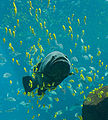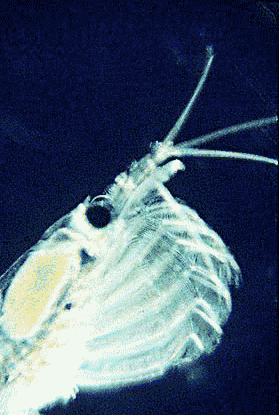
Aquatic predation
Encyclopedia

Most underwater predators combine more than one of these basic principles. For example a typical generalized predator, such as the cod
Cod
Cod is the common name for genus Gadus, belonging to the family Gadidae, and is also used in the common name for various other fishes. Cod is a popular food with a mild flavor, low fat content and a dense, flaky white flesh. Cod livers are processed to make cod liver oil, an important source of...
, combines suction with some amount of protrusion and pivot feeding.
Suction feeding
Suction feeding is a method of ingesting a prey item in fluids by sucking the prey into the predator's mouth. This is typically accomplished by the predator expanding the volume of its oral cavity and/or throat, resulting in a pressure difference between the inside of the mouth and the outside environment. When the mouth is opened, the pressure difference causes water to flow into the predator's mouth, carrying the prey item in with the fluid flow. Bony fish have evolvedEvolution
Evolution is any change across successive generations in the heritable characteristics of biological populations. Evolutionary processes give rise to diversity at every level of biological organisation, including species, individual organisms and molecules such as DNA and proteins.Life on Earth...
ingenious mechanisms, so-called mechanical linkages for rapid and forceful expansion of the buccal cavity.
Ram feeding

Bow wave
A bow wave is the wave that forms at the bow of a ship when it moves through the water. As the bow wave spreads out, it defines the outer limits of a ship's wake. A large bow wave slows the ship down, poses a risk to smaller boats, and in a harbor can cause damage to shore facilities and moored ships...
in the fluid which pushes the prey away from the jaws, but this can be avoided by allowing water to flow through the jaw. This can be accomplished by means of an expandable throat, as in snapping turtle
Snapping turtle
The common snapping turtle is a large freshwater turtle of the family Chelydridae. Its natural range extends from southeastern Canada, southwest to the edge of the Rocky Mountains, as far east as Nova Scotia and Florida and as far southwest as northeastern Mexico...
s and baleen whales, or by allowing water to flow out through the gills, as in shark
Shark
Sharks are a type of fish with a full cartilaginous skeleton and a highly streamlined body. The earliest known sharks date from more than 420 million years ago....
s and herring
Herring
Herring is an oily fish of the genus Clupea, found in the shallow, temperate waters of the North Pacific and the North Atlantic oceans, including the Baltic Sea. Three species of Clupea are recognized. The main taxa, the Atlantic herring and the Pacific herring may each be divided into subspecies...
. A number of species have evolved narrow snouts, as in gar fish and water snake
Water snake
Different snakes are called water snakes. Most are colubrids. "Water snake" is also sometimes used as a descriptive term for any snakes that spend a significant time in or near fresh water, such as any species belonging to the family Acrochordidae...
s
.
Herring
Herring
Herring is an oily fish of the genus Clupea, found in the shallow, temperate waters of the North Pacific and the North Atlantic oceans, including the Baltic Sea. Three species of Clupea are recognized. The main taxa, the Atlantic herring and the Pacific herring may each be divided into subspecies...
s often hunt copepods. If they encounter copepods schooling
Shoaling and schooling
In biology, any group of fish that stay together for social reasons are said to be shoaling , and if, in addition, the group is swimming in the same direction in a coordinated manner, they are said to be schooling . In common usage, the terms are sometimes used rather loosely...
in high concentrations, the herrings switch to ram feeding. They swim with their mouth wide open and their opercula
Operculum (fish)
The operculum of a bony fish is the hard bony flap covering and protecting the gills. In most fish, the rear edge of the operculum roughly marks the division between the head and the body....
fully expanded. Every several feet, they close and clean their gill raker
Gill raker
Gill rakers in fish are bony or cartilaginous processes that project from the branchial arch and are involved with filter feeding tiny prey. They are not to be confused with the gill filaments that compose the bony part of the gill. Rakers are usually present in two rows, projecting from both the...
s for a few milliseconds (filter feeding). The fish all open their mouths and opercula wide at the same time (the red gills are visible in the photo above—click to enlarge). The fish swim in a grid where the distance between them is the same as the jump length of the copepods.
Pivot feeding
Pivot feeding is a method to transport the mouth towards the prey by an upward turning of the head, which is pivoting on the neck joint. PipefishPipefish
Pipefishes or pipe-fishes are a subfamily of small fishes, which, together with the seahorses, form the family Syngnathidae.-Anatomy:...
such as sea horses and sea dragon
Sea Dragon
-Fish:* Leafy sea dragon * Weedy sea dragon -Military:* Operation Sea Dragon , a military operation* MH-53E Sea Dragon, a helicopter* USS Seadragon, two ships of the United States Navy...
s are specialized on this feeding mechanism. With prey capture times of down to 5 ms (shrimpfish
Shrimpfish
Shrimpfish, also called razorfish, are five small species of marine fish in the subfamily Centriscinae of the family Centriscidae...
Centriscus scutatus) this method is used by the fastest feeders in the animal kingdom.
The secret of the speed of pivot feeding is in a locking mechanism, in which the hyoid arch
Hyoid arch
The second pharyngeal arch or hyoid arch assists in forming the side and front of the neck.-Skeletal elements:From the cartilage of the second arch arises*Stapes,*Styloid process,*Stylohyoid ligament, and...
is folded under the head and is aligned with the urohyal which connects to the shoulder girdle. The trigger mechanism of unlocking is debated, but is probably in lateral adduction.
Protrusion
Protrusion is the extension of the mouth towards the prey, via mechanical linkages. Protrusion is only known in modern bony fishes, which possess many forms of coupled linkages in their head. Remarkable examples are the slingjaw wrasse and the sand eelSand Eel
Sand eel or sandeel is the common name used for a considerable number of species of fish. Most of them are sea fish of the genera Hyperoplus , Gymnammodytes or Ammodytes...
which can protrude their mouth by several centimeters.
Filter and suspension feeding

Filter feeding
In filter feeding, the water flow is primarily generated by the organism itself, for example by creating a pressure, by active swimming, or by ciliaryCilium
A cilium is an organelle found in eukaryotic cells. Cilia are slender protuberances that project from the much larger cell body....
movements.
Suspension feeding
In suspension feeding, the water flow is primarily external or if the particles themselves move with respect to the ambient water, such as in sea lilies.See also
- Cleaner fishCleaner fishCleaner fish are fish that provide a service to other fish species by removing dead skin and ectoparasites. This is an example of mutualism, an ecological interaction that benefits both parties involved. A wide variety of fishes have been observed to display cleaning behaviors including wrasses,...
- Feeding behaviour of fish
- LepidophagyLepidophagyLepidophagy is a specialised feeding behaviour in fish that involves eating of scales of other fish. Lepidophagy is widespread, having been independently evolved in at least five freshwater families and seven marine families...
- List of feeding behaviours
- PaedophagyPaedophagyPaedophagy literally means the "consumption of children". It is a term used to describe the feeding behaviour of fish, or other animals, whose diet is partially, or primarily the eggs or larvae of other animals. The term is frequently applied to various species of cichlid fish from Lake Malawi of...
External links
- FishBaseFishBaseFishBase is a comprehensive database of information about fish species . It is the largest and most extensively accessed online database on adult finfish on the web...
is a comprehensive database of bony fishes: /fishbase.org

